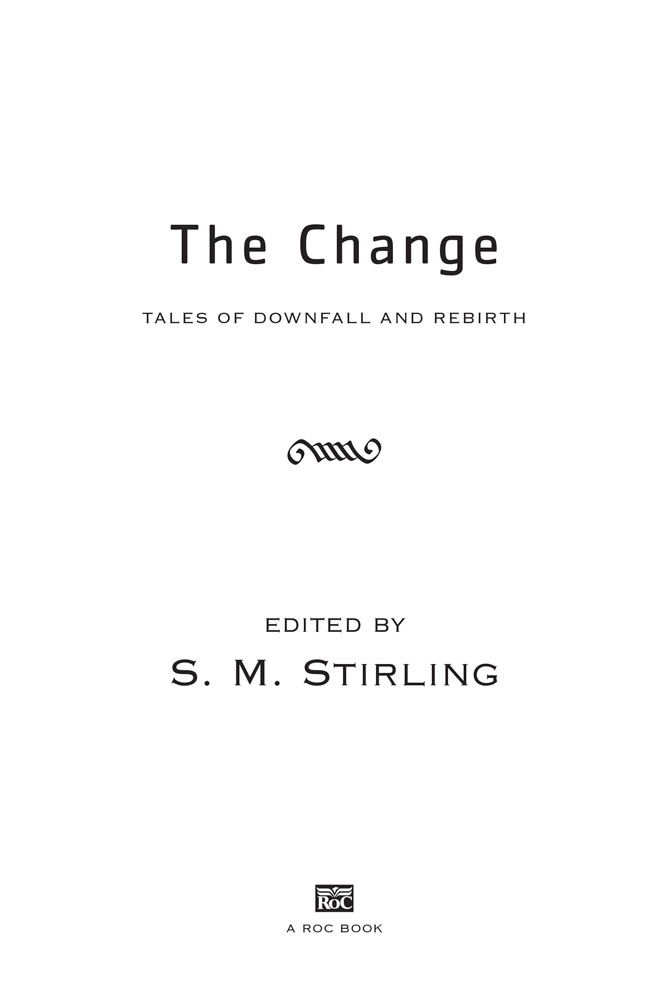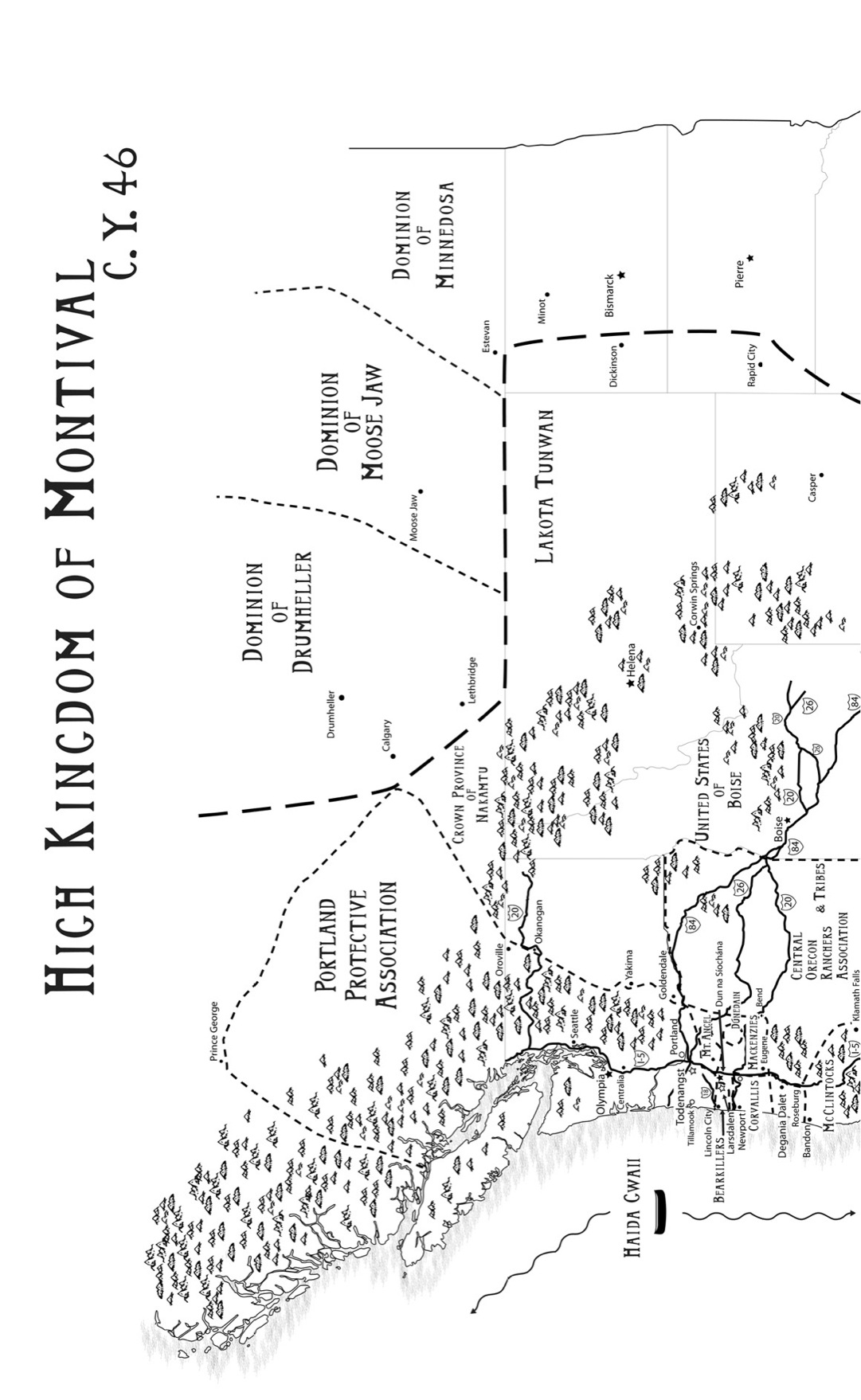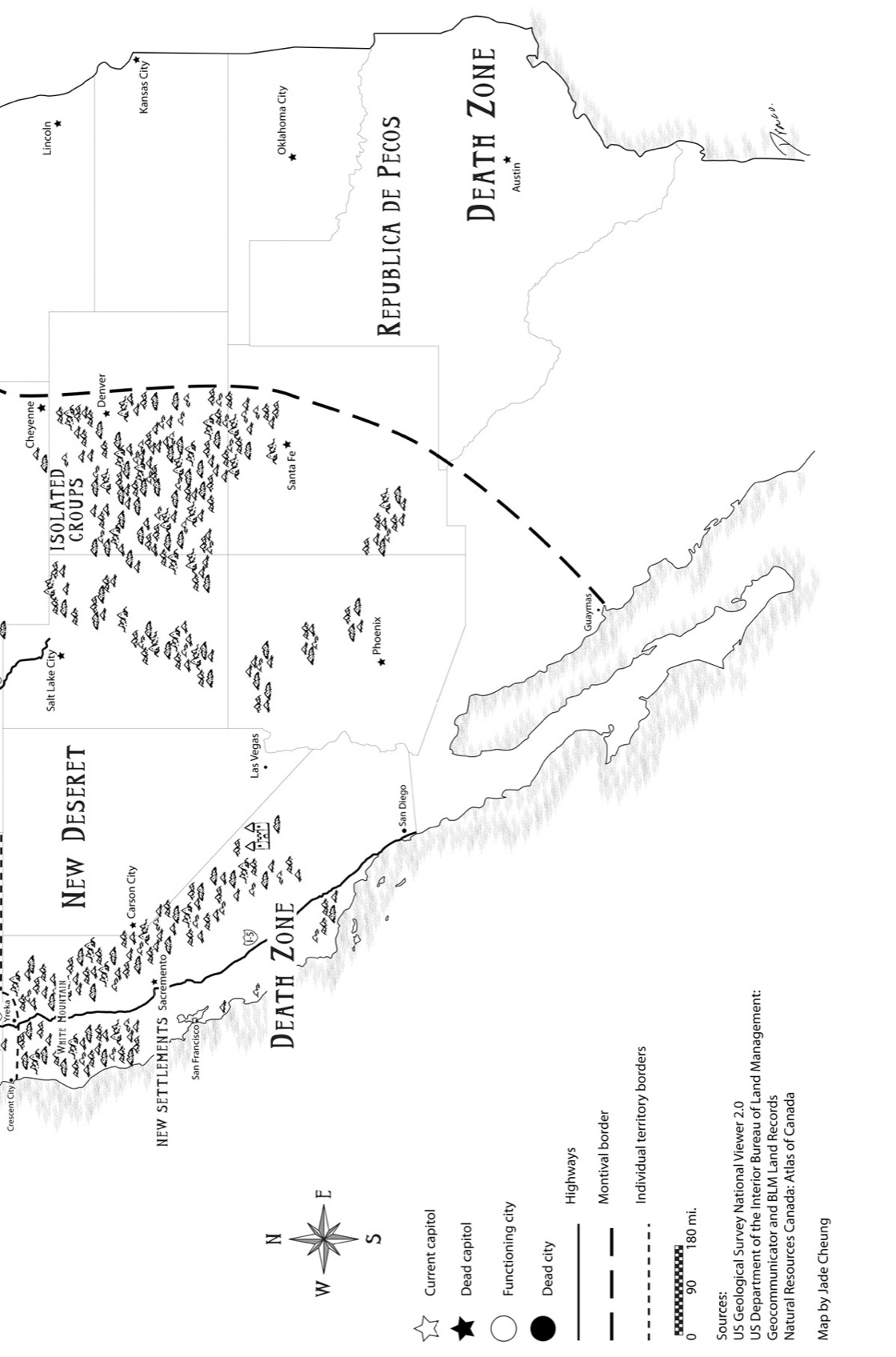Tales of Downfall and Rebirth
Read Tales of Downfall and Rebirth Online
Authors: S. M. Stirling


Â
Island in the Sea of Time
Against the Tide of Years
On the Oceans of Eternity
Â
Dies the Fire
The Protector's War
A Meeting at Corvallis
Â
The Sunrise Lands
The Scourge of God
The Sword of the Lady
The High King of Montival
The Tears of the Sun
Lord of Mountains
The Given Sacrifice
The Golden Princess

Published by the Penguin Group
Penguin Group (USA) LLC, 375 Hudson Street,
New York, New York 10014

USA | Canada | UK | Ireland | Australia | New Zealand | India | South Africa | China
A Penguin Random House Company
First published by Roc, an imprint of New American Library,
a division of Penguin Group (USA) LLC
Copyright © S. M. Stirling, 2015
Introduction: The Change as Setting and Secondary World copyright © S. M. Stirling, 2015
“Hot Night at the Hopping Toad” copyright © S. M. Stirling, 2015
“Rate of Exchange” copyright © A. M. Dellamonica, 2015
“Tight Spot” copyright © Kier Salmon, 2015
“Against the Wind” copyright © Lauren C. Teffeau, 2015
“The Demons of Witmer Hall” copyright © M. T. Reiten, 2015
“Bernie, Lord of the Apes” copyright © John Jos. Miller, 2015
“The Seeker: A Poison in the Blood” copyright © Victor Milán, 2015
“Grandpa's Gift” copyright © Terry D. England, 2015
“Fortune and Glory” copyright © John Birmingham, 2015
“The Venetian Dialectic” copyright © Walter Jon Williams, 2015
“The Soul Remembers Uncouth Noises” copyright © John Barnes, 2015
“Topanga and the Chatsworth Lancers” copyright © Harry Turtledove, 2015
“The Hermit and the Jackalopes” copyright © Jane Lindskold, 2015
“The New Normal” copyright © Jody Lynn Nye, 2015
“A Missed Connection” copyright © Emily Mah Tippetts, 2015
“Deor” copyright © Diana Paxson, 2015
Penguin supports copyright. Copyright fuels creativity, encourages diverse voices, promotes free speech, and creates a vibrant culture. Thank you for buying an authorized edition of this book and for complying with copyright laws by not reproducing, scanning, or distributing any part of it in any form without permission. You are supporting writers and allowing Penguin to continue to publish books for every reader.
 REGISTERED TRADEMARKâMARCA REG
REGISTERED TRADEMARKâMARCA REG
ISTRADA
LIBRARY OF C
ONGRESS CATALOGING-I
N-PUBLICATION DATA:
The change: tales of downfall and rebirth / edited by S. M. Stirling.
pages cm.
ISBN 978-0-698-14169-8
1. Regression (Civilization)âFiction. 2. Science fiction, American. 3. Alternative histories (Fiction), American. I. Stirling, S. M., editor.
PS648.S3C466 2015
813'.0876208âdc23 2014047237
PUBLISHER'S NOTE
This is a work of fiction. Names, characters, places, and incidents either are the product of the authors' imaginations or are used fictitiously, and any resemblance to actual persons, living or dead, business establishments, events, or locales is entirely coincidental.
Version_1
Â
The Seeker: A Poison in the Blood
The Soul Remembers Uncouth Noises
Topanga and the Chatsworth Lancers


N
The Change as Setting and Secondary World
T
here are a number of perils you can encounter when building a fictional world, particularly if you intend to set a number of stories in it. Running out of story you really want to tell, which induces boredom, is oneâArthur Conan Doyle eventually desperately tried to kill off Sherlock Holmes, whose fame was obscuring the historical novels that he felt (with some justification, they're very good) were his best work. Edgar Rice Burroughs' reputation would probably be much higher if he'd written only the first three or four books in his Tarzan and John Carter of Mars series, though more with the former than the latter. Africa was wall-to-wall Lost Races and Lost Cities by the 1940s, and you'd think some would show up from the cabins of the Imperial Airways planes flying over it by then.
Which brings up another potential problem: simply
running out of space
, even if you want to continue and have stories to tell.
Patrick O'Brian ran into this problem with his wonderful Aubrey-Maturin series, set during the Napoleonic Wars; eventually he was reduced to unofficially splitting the year 1813 into, as it were, 1813a and 1813bâsort of alternate history versions of the penultimate year!
The wars against Napoleon spanned more than a decade; if you throw in the beginning of the struggle against Revolutionary France it covers a full generationâaround twenty-five years, with one short truce. Men like Stephen Maturin and “Lucky” Jack Aubrey would have spent their entire adult careers in the period between the fall of the Bastille and Napoleon's exile to Saint Helena, and by the end of it most of their subordinates would have been
born
into the wars. That's more than enough for a series of books!
What tripped O'Brian up was simply that he didn't anticipate how many books he
would
be writing with this (quite large) cast of characters, and so passed over a good many years as he skipped between the time periods of the earlier books.
I took this lesson to heart when starting the novels of the Change, what some call the Emberverse. It tied into another desire, that of making a world that felt
ample
. Even if you're worldbuilding for a single novella, it should feel “big,” not fading into nothingness beyond the tight frame, not “thin.” The characters should be aware of an entire universe around them, full of people and things going about their own business. Look at our own world, even in this age of globalization when there's scarcely a city on the planet where you can't ask directions or order lunch in English. How vast and varied and interesting it is, both in terms of nature and of how human beings live on it and with each other!
Many of the great fantasistsâLe Guin, Howard, Tolkien, Martinâhave achieved this feeling of having an entire world that exists on its own, with the narrative taking place in only part of it. Howard was one of my early influences; I spent a hot cross-country trip in the late sixties dripping watermelon juice on the Lancer
Conans
as my family drove an un-air-conditioned car from New Jersey to Los Angeles.
He achieved it by using what was supposedly, like Tolkien's Middle Earth, the remote past of our world. Even the maps of the Hyborian Age and Middle Earth are similar, if you look carefully. Both Tolkien and Howard did glorious mashups (the concept is older than the term) of historical cultures in their antediluvian worlds. Tolkien has late-medieval Gondor, Anglo-Saxon riders of Rohan, largely Nordic Dwarves, Regency English yokel hobbits, vaguely Middle Eastern and Central Asian Easterlings and Corsairs, plus the totalitarian nightmare of Mordor, with its pollution and its population known by their file-numbers. Howard went completely berserk, and had high-camp-medieval Aquilonians, English longbowman Bossonians, ancient Egyptians in Stygia, Afghans in (where else?) Afghulistan, and something close to nineteenth-century Zulus and Sudanese on the “Black Coast.” Not to mention Vikings, Cossacks, Bedouin, archaic-Semitic more or less Assyrians and Babylonians in the cities of Shem with their ziggurats and brass idols, seventeenth-century buccaneers, eighteenth-century pirates, Turks, Renaissance Spaniards, and Picts who are pretty much Iroquois as seen by the frontiersmen of the Mohawk valley with the odd demon and giant snake thrown into the slumgullion for flavor.
Conan, of course, was essentially pre-Christian Irish, and cheerfully chopped up an entire multicultural host of opponents without fear or favor.
Taking the planet Earth (geographical amplitude and variety) and historically attested cultures (human, ditto) solves the most basic problem of worldbuilding; it's extremely hard to come up with an entire world and its inhabitants and be convincing, to avoid thinness and sameness as everything takes on the cast of your own mind. Not to mention your own limitations with regard to geography and ecology. Hence the multitudes of one-note planets in science fiction; desert world, ice world, and so forth, often inhabited by races who have only one “hat” or trait. Super-logical, super-emotional, super-aggressive, you name it! As the saying goes, worldbuilding is good occupational therapy for lunatics who think they're God, and a lesson in the almost paralyzing complexity and interconnectedness of reality.
This has become the Stock Fantasy World; an ancient or parallel Earth with historically based cultures. This can be done well (Westeros) or badly (I shall not specify, and let the libel lawyers starve). It has the virtue of giving you an unlimited canvas; after all, our own Earth is the “worldbuilding project” of endless mimetic fiction.
Another possible setting is the post-apocalyptic wasteland, where a “new future past” creates analogues to historical settings; Andre Norton was fond of this and did it very well.
Which brings me to the world of the Change.
When I set out to do the Nantucket trilogy (beginning with
Island in the Sea of Time
) I knew that I'd eventually return to the world Nantucket left behind when it was plunged into 1250 BCE. And that as that ancient world received the technology of the late twentieth century when a community of thousands of Americans from 1998 was dumped into its midst, so the world left behind would be denied the high-energy-density technologies. Electronics and electricity; heat engines of all kinds; and the electrochemical and high-pressure, high-energy chemical processes dependent on them.
That gave me the big worldâoursâto work with, rendered even bigger by the sudden removal of fast communications and travel. Naturally, losing the technological basis of the great world-machine in 1998 would cause unimaginable chaos and destruction, comparable to a full-scale global thermonuclear exchange at the peak of the Cold War in immediate devastation and removing the possibility of reconstruction on the same basis.
Old cultures and nations would crash and new would, eventually, be born.
That
basic story has been told many times in science fiction, and generally with more of a time gap is the basis of a fair bit of fantasy as wellâ
The
Dying Earth
by Vance, for instance, or Alyx Dellamonica's new Stormwrack series that begins with
Child of a Hidden Sea
. Even the specific removal of higher technology isn't entirely original to me, of course: Steven Boyett's
Ariel
is a lovely example, though more overtly fantasy. Dragons lairing in the Great Smoky Mountains, anyone?
But what sort of new cultures would arise in the wake of this
particular
apocalypse I'd come up with? Here I got hints from my subconscious, in the way I usually do when contemplating new booksâscenes and characters spontaneously appear; one of them was Juniper Mackenzie sitting by a campfire in front of her Romany wagon, and somehow I knew she was a witch (in the strict sense, that is, a Wiccan). Inspiration . . . but inspiration is cheap. It's being able to connect the dots that's important.
The Change is not a random disaster, cataclysmic though it is; it's not an asteroid hitting the earth, and it's not something like nuclear war or ecological collapse that we might do to ourselves. It's precisely tailored to remove certain possibilities. And it involves what is, as far as any human being can tell, a deliberate alteration in the fundamental laws of nature.
A disaster like that wouldn't just have physical consequences; it would have cultural and ideological-religious ones. Modernism, scientistic-materialist naturalism, would be shot through the head for any but the most fanatical of its devotees, most of whom would perish with the great cities anyway. Technology wouldn't necessarily be reduced to a medieval level; there's nothing to prevent people from using McCormick reapers, water-powered machine tools and antiseptic surgery in areas that preserved some cultural continuity. But the structures of belief based on the scientific and industrial revolutions, at least the more overt and conscious ones, would be dead as the dodo because their basic presumptions would be discredited. The invariability of natural law, for instance.
Human beings
need
ideas, though. We don't live in the natural world alone; we live in a world of shared perceptions, assumptions, beliefs. You can't make sense of the raw data of experience without some inner framework of ideas, a theory of how things work. It seemed to me that people in the situation I'd postulated would often fall back on the past, on the ways of their ancestors. To a certain extent that would be inevitable, because the material underpinnings of our high-modernist, post-modernist world had been traumatically removed.
But as a character in an upcoming Change book notes, “History cannot be completely undone, even by the Change, nor can the past be truly brought back even if you wear its clothes.”
Groups of survivorsâoften coalescing around some charismatic obsessive leader and his immediate followersâwould think they were returning to the ways of their ancestors. What they would actually be creating would be
new
societies based on
myths, stories and legends
about the past. A group of Wiccans might call themselves a Clan and adopt Gaelic terminology and wear kilts (an eighteenth-century invention by the way), but they wouldn't be much like a group of pre-Christian Celts. A knight of the SCA might contrive to build a kingdom with (ferroconcrete) castles, knights in plate armor made in hydraulic presses and a feudal-monarchical structure, but it wouldn't be much like eleventh-century Normandy. Too much memetic technology has developed in the interim. Isolated ranches in the American West (or estancias in Argentina or stations in Australia) might think they were reverting to a more recent heroic past of bold pioneers, and traumatized English survivors led by Guards officers might think they were reestablishing a myth of Deep England; they'd be just as wrong, though more subtly so, beneath the chaps and the smock-frocks.
This has happened before. The ghost of Rome haunted the Western world for a thousand years and more, with everyone who could trying to appropriate its manna by emulationâit's not an accident that we are governed by a Senate from a marble building with domes and columns. That doesn't mean we're actually Romans, and for that matter the Holy Roman Empire of the German Nation was neither Holy, Roman, nor an Empire, and a lot of its population weren't Germans.
And the
people
who survived the Change would be inescapably modern no matter how disillusioned with the formal ideological superstructure of modernity, often in ways that they weren't conscious of. Though . . . what would their children and grandchildren, raised in a world where a mile was once more a long way, be like? Here insert a glyph of authorial hands being rubbed together in glee.
Throw in the Supernatural (in a Clarkean sense) and you've got what I decided would be a background as big and varied as the real world. It would have an array of cultures as colorful as anything in pulp fiction . . . not least because in some cases they were half-deliberately
based
on pulp fiction and half-remembered historical novels and bad movies. Why not? Charlemagne's Empire was based on equally bogus memories of Rome. As a bonus, they would usually be more psychologically accessible to modern Western sensibilities than something more genuinely archaic, for the real thing is always alien and often outright repulsive to many.
They would build their castles from our ruins, and conduct their wars and Quests along the crumbling line of our roads. The ancient past that gradually became half-understood mythâwas
Jurassic Park
fiction or fact?âwould be
our present.
Instead of sending a single individual or small group through a “portal” to another world, I could send the
whole world
to another world.
I had my own Hyborian Age, my own Middle Earth, but accessible through Google Maps! Including a society founded by a mildly insane Tolkien fangirl who thinks that she and her friends are the Dúnedain Rangers amid the Douglas fir and redwoods . . .
The rest, as they say, is histories. The novels of the Change, or Emberverse (what comes after
Dies the Fire
but embers?) have been far and away my most popular work. The setting gives a stage interesting enough and big enough for a large number of stories I've found fun to write, especially when combined with my cunning trick of giving all the protagonists descendants.
Herein are some other authors who've found the world of the Change a fun canvas on which to paint, ranging from seeking fortune and adventure in the ruins of Sydney to Venetian and Greek galleys clashing in the Mediterranean. Enjoy!